Seeing the Sea
18 December 2020
ShareWhy the sea is such a compelling subject.
Lamorna Ash
Lamorna Ash writes for The TLS and is the author of Dark, Salt, Clear: Life in a Cornish Fishing Town, shortlisted for the Wainwright Prize 2020.
In my family home, we have three paintings of a particular stretch of Cornish coast – Porthkidney Beach, just across the sand dunes from where my mother grew up, in the village of Lelant. The paintings are incredibly simple: thin strips of pale sand half-swallowed by the rich blue of the sea and sky that together take up three-quarters of the canvas. The artist, John Miller, (1931-2002), spent most of his life in a cottage overlooking the estuary that divided Lelant from its neighbouring village, Hayle. Miller’s work has since become synonymous with idyllic Cornish summers, his paintings reproduced on postcards and posters thousands of times over.
Thomas Whitcombe (1752-1824), ‘The Battle of Camperdown, 11th October’, 1797, oil.
Rountree Tryon - A33.
Why is it that some people feel they must keep images of the sea close to them? Perhaps this allegiance is related to where you grow up or choose to live out your years; perhaps it is less obvious, an ineffable part of the psyche connecting you to that mutable substance that lies between the land.
When I ask my mother what it means to have these artworks in her landlocked Wiltshire house, she tells me they are a way through to her youth: the place that matters most to her, where her grandmother, mother and now brother are buried in the small churchyard above the sea.
Bonhams is the only international auction house that retains its Marine Sale. This takes place twice a year – grand paintings of sea battles, nautical memorabilia and relics of naval history, all selling from several to hundreds of thousands of pounds. Sarah Reynolds, a maritime picture specialist at Christies, told me that, though they no longer have a separate maritime sale at Christies, the market remains stable and privately driven. In 2012, the contemporary maritime artist Jamie Medlin made a Christies’ auction record, with his photorealistic painting of J-class yachts on the Solent selling for £127,250.
And yet, in America, several gallery owners have suggested sales in maritime art are falling. Monique Foster, director of the Maritime Gallery in Connecticut, which recently folded as a result of the pandemic, suggested that, “Many of the big collectors aren’t buying more marine art, and their children don’t want it.”
It makes sense that tastes are changing. The maritime art on sale in prestigious galleries and auction houses tends to celebrate empire – Christies’ clients often have special interests in Napoleon or Nelson.

Charles Pears P.S.M.A. (1873-1958), ‘Needles by moonlight’, oil.
Rountree Tryon - A33.
Jamie Rountree, the director of Rountree Tryon Galleries, agreed that there has been a decline in sales of maritime art over the past thirty years. But, since 2009, he tells me, “there has actually been a small uplift in buyers.” A potential explanation for this is a number of clients moving from London flats to larger, countryside homes, “which suit a more old-fashioned look rather than contemporary art.”
In the twentieth century, a new kind of maritime art emerged, its subject more explicitly personal. Rountree tells me that the “1930’s ‘look’” of graphic, poster-like paintings of the sea – produced by artists such as Norman Wilkinson and Charles Pears – is popular with his clients. As the writer Lily Le Brun, whose book Looking to Sea: Britain Through the Eyes of its Artists is to be published in 2022, explained, “Images of the sea are revealing not only of the time in which the artist lives, but of the personal, prosaic and philosophical concerns that weave an artwork into being.”

Dame Laura Knight RA (1877-1970), ‘Lamorna Cove’.
Walker Galleries - A1.
In the late nineteenth century, a group of painters formed an artist colony in the Cornish port town of Newlyn, attracted by the clarity of light, the potency of the sea and the simplicity of those who sailed upon it. Unlike the fishermen who became their chief subject, the painters of the Newlyn School, including Walter Langley, Stanhope Forbes and Laura Knight, were able to observe the sea from a safe distance, creating sombre portraits of fishwives praying for their husbands’ return to harbour and fishermen lamenting their lack of catch.
Alfred Wallis, (1855-1942), was first fisherman, then painter. He began his career as a mariner, sailing schooners between Penzance and Newfoundland, and later became a deep-sea fisherman, operating out of St Ives. It was only in the wake of his wife’s death in 1922, when Wallis was seventy, that his attention turned to painting. Like the ‘Ship Portrait’, one of the earliest forms of maritime art, most of Wallis’s paintings were of the ships he himself had worked upon, done on scraps of old cardboard with thick ship paint. He painted six days a week, his cottage soon filled with his artworks.
Wallis’s work was championed as an example of ‘naïve art’ – art made by those without formal training, recognisable for its distorted scales and skewed perspectives. To view a Wallis painting is to feel like you are floating somewhere above the scene: the boats themselves dwarf the land, while cartoonish figures perch upon their decks. It is a world away from the remote, melancholic depictions of the sea and the men who work upon it envisioned by the Newlyn School artists.
In a letter to the art collector H.S. Ede, Wallis wrote that he worked “out of my own Memery what we may never see again as Things are altered all to gether.” Painting allowed him to hold onto the past, while all around him the old boats he had known were being broken up in favour of mechanised trawlers. He painted the sea because it was all he knew, because what other subject could there possibly be for a man who had lived a life half on the water?
Wallis and Miller’s devotion to their subject reminds me of the American poet Elizabeth Bishop, for whom the sea was equally a constant theme. In ‘At The Fishhouses’, she wrote “I have seen it over and over, the same sea”. The sea is an attractive subject because it both is and is not the same each time you turn again to face it. Perhaps this is what makes art pertaining to the sea so compelling; one experiences a sense of yearning while viewing them, feeling keenly that what we are seeing will never be the final word, will never be the same sea.

